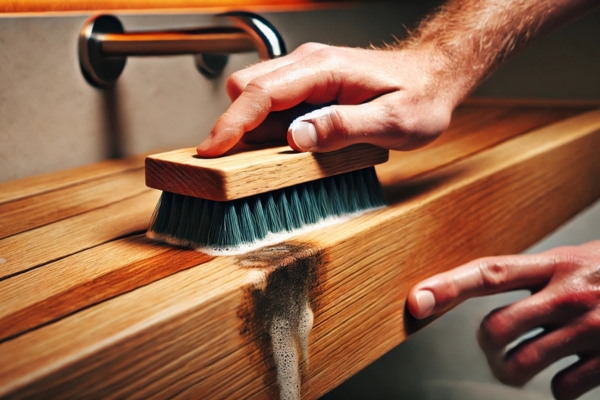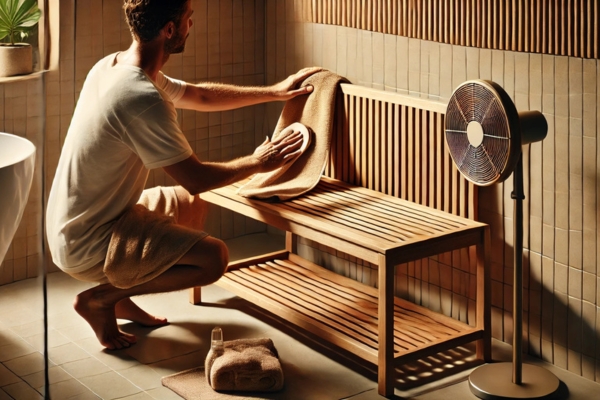Teak shower benches—those sturdy, stylish, water-loving fixtures—are the unsung heroes of your bathroom. Known for their durability, water-resistance, and that natural wood charm, they seem impervious to the relentless humidity and steam. But wait… even teak isn’t invincible. Enter mold: that sneaky, greenish invader that thrives in the steamy, damp corners of your shower. Sure, your teak bench may be resilient, but mold? Not so much. If left unchecked, it can leave unsightly stains and cause long-term damage. But don’t worry! With the right tools and a bit of elbow grease, you can bring your teak bench back to life. Let’s dive into how to clean mold off your teak shower bench, step-by-step.
What You’ll Need For The Job
Before you get your hands dirty (and before your teak gets dirty), let’s gather the essentials for this mold-busting mission.
- Cleaning Solutions: You’ll want something that’s tough on mold but gentle on teak. The classics? Vinegar and water, baking soda and water, or a teak-specific cleaner.
- Soft Brush: Think toothbrush or small scrubbing brush—something to lift the mold without scratching the delicate teak surface.
- Cloths or Towels: Soft and absorbent towels are essential for blotting away excess moisture post-cleanup.
- Rubber Gloves: Mold’s a little too cozy with your skin. Protect yourself from potential irritation with a pair of gloves.
- Spray Bottle: To apply the cleaning solution evenly without drenching your bench in one fell swoop.
Why Mold On Teak Is More Than Just A Nuisance
Mold isn’t just ugly; it’s a villain in your teak bench’s story. Over time, if left unchecked, mold can seep deep into the porous surface of the teaks, leaving behind discoloration and weakening the wood’s integrity. And let’s not forget the health risks—mold can trigger allergies, respiratory issues, and skin irritation. So yeah, it’s time to deal with that green menace before it does more than just mar the beauty of your shower.
Step-By-Step Guide To Cleaning Mold From Your Teak Shower Bench
Step 1: Prepare Your Battlefield (Aka The Shower Area)

First things first: clear the area of personal items. Soap dishes, shampoo bottles, and loofahs don’t need to be in the way while you’re attacking mold. You need space to focus on the task at hand—plus, you don’t want a cleaning solution accidentally splashing onto anything it shouldn’t. Open a window or crank up the fan; airflow is your friend in this battle.
Step 2: Remove The Excess Moisture
Mold loves moisture. So, before you apply your cleaning solution, grab a dry towel and wipe away any water on the surface of your teak bench. Mold loves dampness, so it’s crucial that your wood is as dry as possible before you start. Any soap scum or dirt that’s hanging out on the surface? Give it a gentle scrub with a soft cloth or sponge.
Step 3: Apply Your Cleaning Solution Like a Pro

Now it’s time to get serious. Grab your cleaning solution and apply it to the moldy areas, generously coating the wood. If you’re using a vinegar and water solution, the acidity will help break down the mold. Baking soda’s a little more abrasive, helping to scrub away stains without harming the wood. Spray it on, let it sit for a minute, and get ready to scrub.
Step 4: Gentle Scrubbing, No Hulk Mode

Here’s the trick: scrub gently. While you might be tempted to attack the moldy with all your might, remember that teak is delicate. Use your soft brush to carefully work away at the mold, focusing on the spots that need the most attention. Don’t forget to get under the seat and around the edges—the mold Can Hide There Too. If It’s Stubborn, Repeat The Process.
Step 5: Rinse Off That Moldy Mess

After scrubbing, it’s time to rinse. Use clean, warm water to wash away all the moldy and cleaning solution. Make sure you get all the residues out—any leftover cleaner could damage your teak in the long run. Rinse, rinse, rinse until the wood feels clean.
Step 6: Drying—The Secret To Preventing Future Mold

Now, here’s the part where many people go wrong: drying. Moldy thrives in moisture, so it’s essential that you dry your teaks completely. Grab a soft towel to blot away excess water, then let the bench air dry. If you’ve got good airflow or a fan handy, let it help speed up the process. A dry bench equals a happy bench.
Natural Solutions For The Eco-Friendly Mold Remover

If you’re a fan of eco-friendly cleaning, you’re in luck! Natural solutions like vinegar and water, or baking soda and water, are fantastic for removing mold from your teak bench. Vinegar, with its natural disinfecting properties, tackles the moldy head-on, while baking soda works as a gentle scrub to lift stubborn stains. Even lemon juice can join the fight—its acidity helps lift the mold, and it smells refreshing!
Commercial Cleaners: A Double-Edged Sword?
If you’re opting for a commercial cleaner, be cautious. Make sure the product is specifically designed for teak. Some harsh chemicals can strip away the wood’s natural oils, leaving it vulnerable to more moldy in the future. Always do a patch test in an inconspicuous spot first. If it passes, then go ahead and use it. But always—always—read the labels.
Prevention: Keeping Mold At Bay
So you’ve cleaned your teak bench, and it’s looking fabulous again. Now, let’s keep it that way! Apply a protective teaks oil or sealant to guard against future moisture damage. Ensure your bathroom is well-ventilated—open windows, run the exhaust fan, and wipe down the bench after each use to keep moisture at bay. Prevention is the name of the game!
Spotting The Signs Of Mold Damage
Mold damage isn’t always visible right away. Sometimes, you’ll notice dark spots or discoloration on the surface. In more severe cases, the wood may become soft or spongy to the touch. A musty odor is another red flag that mold has taken root. If you spot any of these signs, it’s time to spring into action.
How Often Should You Clean Your Teak Shower Bench?
How often should you give your teak bench the cleaning love it deserves? Ideally, once a month. But if your bathroom is especially humid or you use the shower often, you may need to clean it more frequently. Regular cleaning not only prevents mold but also helps your bench stay in tip-top shape.
Teak Care Tips To Keep Your Bench Looking Fresh
Teak is a durable, resilient wood, but like anything valuable, it needs some TLC. Oiling your teak bench every few months will help preserve its color, keeping it looking fresh while reinforcing its water resistance. When applying the oil, always go with the grain, and make sure to wipe off any excess to avoid a sticky mess.
Avoiding Common Mistakes While Cleaning
We’ve all been there—wanting to tackle mold with all the energy of a cleaning whirlwind. But here’s a tip: don’t use steel wool or wire brushes. They’ll scratch up your bench faster than you can say “moldy.” Also, under no circumstances should you ever use bleach on teak. It’ll discolor the wood and weaken it. Finally, don’t skimp on the drying step. If your bench stays damp, moldy will just come back with a vengeance.
The Teak Advantage For Shower Benches
Why is teak the go-to choice for shower benches? Its natural resistance to moisture makes it perfect for bathrooms. And its durability means that, with proper care, your teak bench can withstand years of daily use, even in the most humid conditions.
Severe Mold Growth: What To Do When It’s Gone Too Far
If the mold problem is really out of hand, you may need to resort to sanding the affected areas to remove deeper stains. Once that’s done, be sure to re-oil or reseal the wood to protect it from future damage. If the moldy has infiltrated deeply, it might be worth calling in a professional to assess the situation.
Eco-Friendly Mold-Busting Options
If you’re all about keeping things green, you’ll love these natural solutions for moldy removal: vinegar, baking soda, and lemon juice. These all-natural ingredients are safe for your teak and the environment, allowing you to clean without causing harm to the planet.
FaQ
How Can I Tell If The Mold Is Gone?
Once you’ve finished cleaning, check for any lingering signs of mold. Dark spots, musty odors, or visible moldy patches are dead giveaways that it’s still there. If the wood looks clean and fresh, and the air smells neutral instead of musty, you’ve likely removed all traces of mold. To be extra sure, you can wipe the surface with a mild disinfectant to ensure all mold spores are gone.
Is It Safe To Use Bleach On Teak Wood?
Absolutely not. While bleach can be effective in some situations, it’s a harsh chemical that can seriously damage teak. Bleach strips the wood of its natural oils, causing it to dry out, crack, or discolor. Instead, stick to natural cleaning solutions, such as vinegar or baking soda, to safely clean your teak bench without compromising its integrity.
How Do I Remove Stubborn Mold Stains On Teak?
Stubborn mold stains can be tricky, but they’re not unbeatable. If you’ve already cleaned the moldy but the stains persist, you can try gently sanding the affected areas with fine-grit sandpaper. Sanding helps to remove deeper stains without damaging the wood’s surface. After sanding, be sure to re-oil or reseal the wood to restore its protective moisture barrier.
How Tall Is A Shower Bench?
Tall is a shower bench, Shower benches typically range between 17 to 19 inches in height, which is considered comfortable for most users to sit on while showering. The height allows for proper support without being too low or high. Of course, custom shower benches can vary, so you may find benches slightly shorter or taller depending on design preferences.
Conclusion
A clean, mold-free teak shower bench not only enhances the aesthetics of your bathroom but also extends the life of the wood. With the proper cleaning techniques, natural solutions, and consistent care, you can keep your teak bench looking beautiful and functional for years to come. Remember, prevention is always easier than treatment, so regular cleaning and good ventilation are your best defense against moldy. Armed with these tips, your teak shower bench is ready to shine—no moldy allowed!


